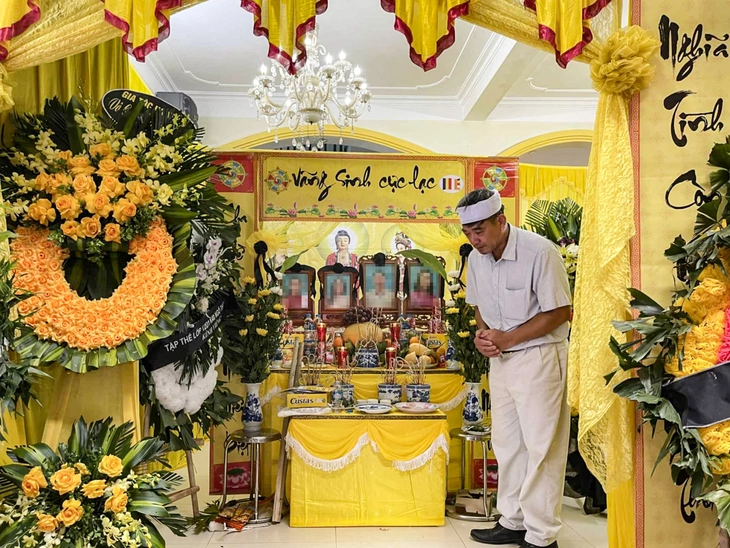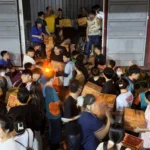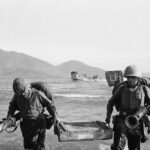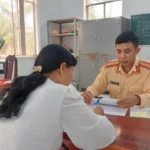In the living room are four memorial portraits of a couple and their two children who perished in the boat capsizing incident. Many visitors couldn’t hold back their tears.
A somber atmosphere enveloped the entrance to Vinh Ninh village (Dai Thanh commune, Hanoi) on July 20—nearly a day after the tourist boat capsized in Halong Bay.
On the temporary altar, four memorial portraits of Mr. N.H.T.’s (born 1973) family stood side by side, with incense smoke curling upward. The cries of family members moved even the strongest visitors to tears.
Mr. N.H.T., Mrs. T.T.N. (born 1974), and their three children had taken a weekend trip to Halong Bay (Quang Ninh). On July 19, they were among nearly 50 passengers aboard the Vinh Xanh 58 boat.
However, a sudden violent storm cut their journey short, sinking the boat into the deep sea. Of the family of five, only one survived.
By the morning of July 20, nearly a day after the incident, the bodies of the four victims were brought back to their hometown for funeral arrangements according to local customs. Their son, P. (born 2007), remained hospitalized in Quang Ninh.
As if out of tears, the relatives of the four victims silently gazed at each other and then at the portraits of the deceased.
Ms. An (a close friend of Mrs. N.) had red, swollen eyes and repeatedly burst into tears while looking at the four portraits placed side by side.
Wiping away tears, she shared that she had known Mrs. N. for over a decade. Though not blood-related, they had always supported each other through hardships, treating one another like sisters.
Just recently, they had exchanged messages. Little did she know that the next morning would bring tragic news.
“I was in complete disbelief until I saw footage of the family on the sinking boat in Halong Bay,” Ms. An said.
According to her, Mrs. N. and her husband had a loving relationship. Mr. T. worked as a driver, while Mrs. N., due to poor health, took on lighter jobs to supplement their income.
Financially strained, especially after Mrs. N.’s diagnosis, the family struggled with medical expenses while raising three school-aged children.
“I’d never known them to travel before. This trip was likely a gift for their son after his university entrance exams. But who could have imagined…” Ms. An said, her voice breaking.
With reddened eyes, Mr. Dung (Mr. T.’s older brother) lit incense and sat quietly in a corner, ignoring the occasional visitors paying respects.
Throughout the funeral, Mr. Dung spoke little. The loss was too immense—his younger brother, sister-in-law, and two nephews gone “too suddenly.” Even now, he struggles to accept the reality.
“I deeply thank the authorities and rescue teams who worked tirelessly day and night to find the victims and support our family,” he expressed.
By the afternoon of July 20, funeral arrangements for Mr. T.’s family were completed.
Earlier that morning, local officials and community representatives visited the family to offer condolences and assist with burial preparations.
The commune authorities provided 20 million VND to cover funeral expenses and pledged to report to the city for further support policies, including long-term assistance for P., the sole survivor.
A tropical convergence zone combined with intense heat triggered a superstorm with winds up to level 10 in Quang Ninh, causing the Halong Bay tour boat to capsize. Meteorological experts confirmed this was unrelated to Typhoon No. 3.
Halong Bay
Halong Bay, located in northeastern Vietnam, is a UNESCO World Heritage Site renowned for its stunning limestone karsts and emerald waters. The bay has a rich geological history dating back over 500 million years and is steeped in local legends, including tales of dragons creating the islands. Today, it is a popular tourist destination for cruising, kayaking, and exploring its picturesque caves and floating villages.
Vinh Ninh village
Vinh Ninh Village is a traditional coastal village in central Vietnam, known for its long-standing fishing culture and scenic beauty. Historically, it has been a vital community for local fishermen, preserving age-old maritime traditions and crafts. The village also features cultural landmarks, such as small temples and communal houses, reflecting its deep-rooted heritage.
Dai Thanh commune
Dai Thanh Commune is a rural area in Vietnam, often recognized for its agricultural significance and traditional Vietnamese village culture. Historically, it has been part of the country’s agrarian economy, with farming and local crafts playing a central role in community life. While not a major tourist site, it reflects the enduring rural heritage and communal lifestyle of Vietnam’s countryside.
Hanoi
Hanoi, the capital of Vietnam, is a city rich in history and culture, dating back over a thousand years to its founding in 1010 under the Ly Dynasty. Known for its well-preserved colonial architecture, ancient temples like the Temple of Literature, and vibrant Old Quarter, Hanoi reflects a blend of indigenous traditions and foreign influences from Chinese, French, and Southeast Asian cultures. Today, it remains a political and cultural hub, celebrated for its bustling street life, culinary heritage, and landmarks such as Hoan Kiem Lake and the Ho Chi Minh Mausoleum.
Quang Ninh
Quang Ninh is a coastal province in northeastern Vietnam, renowned for its stunning natural beauty and cultural significance. It is home to the UNESCO World Heritage Site Ha Long Bay, famous for its emerald waters and thousands of limestone karsts. The region also has a rich history tied to trade, fishing, and coal mining, with landmarks like the Yen Tu Mountain holding spiritual importance as the birthplace of Vietnamese Buddhism.
Vinh Xanh 58 boat
The *Vinh Xanh 58 boat* is a historical wooden vessel used during the Vietnam War, notably in the famous *Battle of Rạch Gầm-Xoài Mút* (1785). It symbolizes the resilience and ingenuity of Vietnamese forces, who employed such boats for strategic riverine warfare. Today, it serves as a cultural relic, reflecting Vietnam’s maritime heritage and wartime history.
Typhoon No. 3
“Typhoon No. 3” is not a specific place or cultural site but rather a term used in East Asia (particularly Japan) to refer to the third typhoon in a given year’s typhoon season. Typhoons are tropical cyclones that often impact regions like Japan, the Philippines, and Taiwan, bringing heavy rain and strong winds. The naming or numbering system helps meteorologists and the public track and prepare for these storms. If you meant a specific location or cultural reference related to a typhoon, please provide more details!
tropical convergence zone
The **Tropical Convergence Zone (ITCZ)**, also known as the Intertropical Convergence Zone, is a belt of low pressure near the equator where trade winds from the Northern and Southern Hemispheres meet, causing frequent thunderstorms and heavy rainfall. Historically, it has been vital for maritime navigation and agriculture, influencing climate patterns in tropical regions. Its position shifts seasonally, following the sun’s zenith, impacting monsoon cycles and weather systems worldwide.






